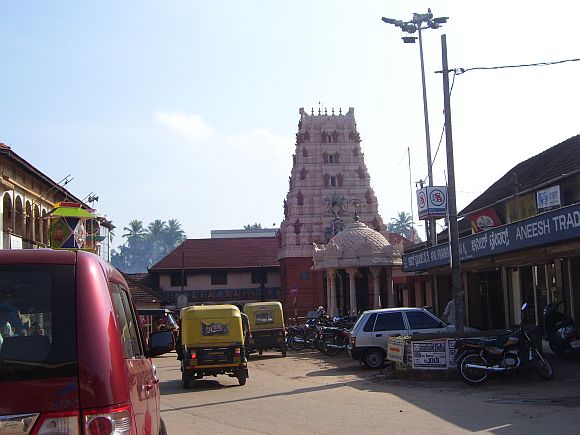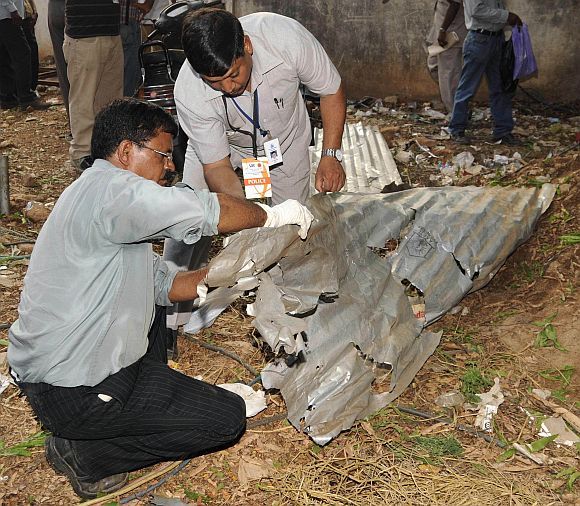Vicky Nanjappa in Bengaluru
When the Indian Mujahideen first made its appearance on the Indian stage in early 2008, the Delhi police came hunting for leads in the coastal town of Udupi in Karnataka. And they did go back with some clues. Vicky Nanjappa reports
The Delhi police had interrogated Mohammad Saif who reportedly told them that he and one of his accomplices had picked up explosives in Udupi. These explosives were allegedly used for the 2008 Delhi blast which took place a month after Bengaluru and Ahmedabad were bombed.
A couple of months back several youth were picked up from Chennai in connection with more recent terror attacks. What foxed investigators was that there were newer modules and the most powerful was in Bihar.
However, while examining the investigations that were also conducted by the Bengaluru police it has been found that a key module continued to operate out of Udupi and this in turn posed a bigger danger to India's national security.
Please ...
Availability of explosive not the only reason for choosing a base
Image: The Naalbeedi (Car Street) in Udupi. In the background is the famous Krishna Matha templePhotographs: Courtesy: Rajaramraok/Wikimedia Commons
Going by the dynamics of a town like Udupi it is pretty strange that the Indian Mujahideen has chosen this area to carry forward its operations. It is known to be a stronghold of the Bharatiya Janata Party, despite which the IM has decided to operate out of this town.
Investigations show that there are a couple of factors that have led to the IM setting shop in this coastal town and if the menace is not cracked soon, it could lead to a bigger headache for security agencies.
Saif, during his interrogation, had told the police that there was easy access to ammonium nitrate in the coastal belt and hence Riyaz Bhatkal, an IM operative and one of India's most wanted men, had told them to source it from this area. It is said that ammonium nitrate is also used by fishermen in the area and hence it had become easier to source.
However, police officials say that choosing a base one has to do more than just the availability of ammonium nitrate. The IM has never found it difficult to source ammonium nitrate and the more important fact is that there is no real tough laws regarding this.
Communally charged local politics help the IM cause
Image: The Malpe beach, near UdupiFor quite some time now there has been talk about the entire Mangalore coast turning into a hub for terror activity.
Mangalore is heavily connected with areas such as Bhatkal and also Kasargod and there have been an influx of certain anti-social elements into these places. Both these areas depend heavily on Mangalore for smuggling activities and it is not strange that they may have used the same network to set up a terror hub as well.
However, the IM has been cautious not to make it operations big in Mangalore city. They have chosen a more low profile Udupi (60 kms away) instead intentionally as the heat would be lower. The other reason is that Udupi, unlike Mangalore, is not a commercial hub and is more of a sleepy temple town which is an added advantage for such activists to carry out operations without being noticed.
What investigators are most worried about is the recruitment of cadres from these areas. Udupi has eternally been an education hub. Students from different parts of the country and also the world can be found in Udupi and also neighbouring Manipal as these are the primary centres for education in Karnataka.
This, according to the police, could be a very crucial factor leading up to recruitments. The Students Islamic Movement of India and the IM have always chosen students for their operations and they could have found no better place than these two towns in coastal Karnataka.
Moreover, they could also find the recruitments to be easier as these belts have been communally charged due to local politics. Communal tensions have been the best reason cited while recruiting terror operatives, it has been found in the past.
In the past few years the police have found a very strong connection between Udupi and operatives from Bhatkal (which is 40 kms from Udupi).
IM's Udupi module behind Chinnaswamy stadium attack?
Image: Forensic experts inspect the site of a bomb blast outside the Chinnaswamy cricket stadium in Bengaluru on April 17, 2010.Photographs: Reuters
Roshan Khan is one such example. Hailing from Bhatkal, Khan had managed operations from hubs in Udupi. This had been found during a major seizure from an IM hub in Udupi three years back when the police recovered AK-47s and also four kilograms of explosives.
During the probe it was also found that some members of the IM located in Udupi had helped not only procure arms but were also used for logistic support. There was also another aspect that came out that terror modules in Kerala were linked to the modules in coastal Karnataka.
The police however would not make the mistake it did in 2008 when it picked up leads and did not go ahead and act upon it.
The recent arrest of IM operatives in Chennai has once again led investigators to believe that the strongest IM modules in India today are in Bihar and coastal Karnataka apart from parts of Kerala.
Delhi police sources say that they would be going through the investigation report and other details that have been picked up by the Karnataka police.
The Bengaluru police also believes that a part of the operation of the IM which carried out the attack at the Chinnaswamy Stadium in the city could have had the support of the module operating out of Udupi.
There have been instructions to keep a close watch on such activities in these areas in particular, as the political weather is something that the IM would try and counter especially in coastal Karnataka.





article